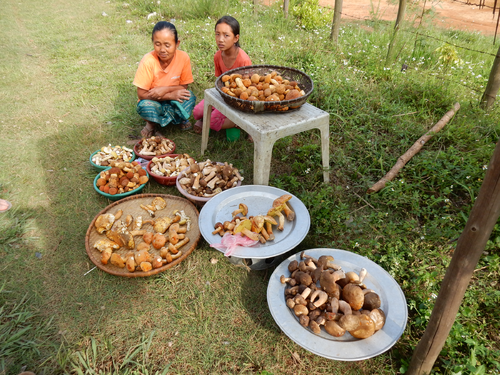
A recent article in the academic journal Science published by Prof. Urmas Kõljalg and colleagues aims to explain the possibilities for identifying species determined based on DNA samples only.
The article was published as a response to David Hibbetts paper "The invisible dimension of fungal diversity". The American mycologist Hibbett argues that huge amount of fungal species cannot be identified and described scientifically as the international code does not permit describing new species based on DNA samples derived from molecular surveys of the environment. However, the Estonian and Swedish scientists show – analysing the same data – how DNA based fungal species have been identified and communicated for several years now using database UNITE (https://unite.ut.ee).

In the forests of Laos the mushroom season has already begun. Among the mushrooms presented on these dishes one can most likely also find species scientifically yet undescribed. The digital object identifiers (DOIs) system created by the scientists in Tartu permits comunication of these species already before they have been granted scientific names. Writing about poisonous mushrooms for example helps to keep people informed, so that cases of intoxication can be avoided more often. (Photo: Urmas Kõljalg)
"Traditionally species are determined based on their morphology and anatomy, in printed books – traditional keys to nature – species are displayed on pictures and in written descriptions. But DNA of fungi can also be found in samples of soil, of leaves, of air, in these circumstances we do not actually have the fungus itself and we cannot identify it visually," Urmas Kõljalg explains the core of the matter. "In this case, species can be determined evaluating their DNA sequences."
The UNITE Species Hypotheses approach demonstrates how the DNA based fungal species can be referred to in a proper scientific manner already before they have been described formally according to the code. This can be done using unique digital object identifiers (DOIs) given to all fungal species in the UNITE database. This keeps all the references automatically connected and machine-readable by other databases as well.
"Even if the species will have its name ten years from now, the DOI code will help us go back and see, where the species was first described and who found it," Urmas Kõljalg says.
For several years now by leading species classification platforms based on DNA sequences more than half a million DOI codes have been used as identifiers of fungal species. UNITE fungal codes are used by the most influential gene bank NCBI also. The UNITE system uses a new paradigm in identifying species, this paradigm was first described by Urmas Kõljalg and colleagues in 2013.
UNITE – the global unified system for the DNA based fungal species – contains information of all the fungal species known from sequence data, hundreds of researchers from all over the world are collaborating. UNITE is hosted by PlutoF cloud, which permits creating very complex databases for various biodiversity data, including DOIs. The development of PlutoF system is supported by the Estonian research infrastructures roadmap project NATARC (http://natarc.ut.ee), EU BON (http://eubon.eu), etc. All scientists can use PlutoF for free.




 RSS news
RSS news Print this article
Print this article
